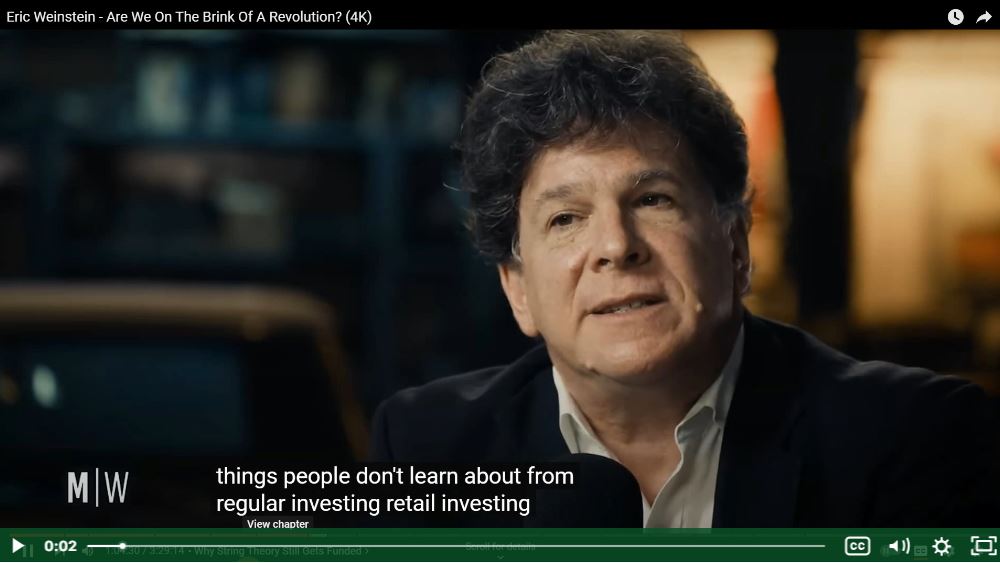Eric Weinstein: Bridging Quantum Physics and Finance
Eric Weinstein is a prominent intellectual whose expertise spans both the realms of quantum physics and finance (including the concept of relative value stock pair trading). With a PhD in Mathematical Physics from Harvard, Weinstein has made significant contributions to theoretical physics, particularly in areas like gauge theory and geometry. He is also the creator of the “Geometric Unity” theory, which aims to unify general relativity with quantum mechanics—an ambitious undertaking in the scientific world.
However, beyond his contributions to physics, Weinstein’s career extends into the financial domain. He has served as Principal of the Natron Group, a hedge fund, and Managing Director of Thiel Capital. At Thiel Capital, he brought his mathematical acumen to the world of finance, specifically focusing on complex trading strategies and financial models. His unique combination of skills allows him to analyze markets through a sophisticated, quantitative lens, especially in fields like hedge funds and relative value trading strategies. In the video below, Weinstein introduces the concept of relative value trades, explaining its mechanics and advantages:

This great clip comes from an amazing interview conducted by Chris Williamson of Modern Wisdom on 6 September 2024 of this unique individual. Full interview is available on YouTube here.
The History of Relative Value Trading Strategies
Relative value trading strategies are sophisticated financial techniques that have been employed by hedge funds for decades. The strategy involves taking advantage of price discrepancies between securities that are related in some way. By going long on an undervalued security and shorting an overvalued one, traders can potentially profit from their relative price movements rather than relying on broader market trends.
Relative value trading originated in the bond markets in the mid-20th century. One of the most notable early adopters of this strategy was the investment firm, Long-Term Capital Management (LTCM), which used mathematical models to exploit price inefficiencies between bonds. Despite LTCM’s eventual collapse in the late 1990s, the relative value approach has continued to evolve, finding widespread application in hedge fund strategies today, particularly in equity and derivative markets.
Growth and Performance of Hedge Funds Using Relative Value Trading
Over the years, hedge funds have significantly grown their assets under management using relative value strategies. This method allows them to hedge risks associated with market direction while focusing on the performance of paired securities within the same sector or asset class. For example, one could bet on the performance difference between two technology stocks, such as Microsoft and Google, by going long on one and short on the other. This hedging mechanism is why many hedge funds have outperformed traditional long-only investment strategies during periods of market volatility.
Relative value trading strategies are now a cornerstone of many hedge funds, contributing to the rapid expansion of the industry. As of recent years, these funds manage trillions of dollars globally, with a portion of that allocated to relative value opportunities across a range of asset classes.
Advantages and Disadvantages of Relative Value Trading
Advantages
One of the primary advantages of relative value trading is its ability to mitigate broad market risks. By focusing on the performance of one security relative to another, the overall market’s ups and downs become less important. This allows investors to generate returns even in bearish or sideways markets. Additionally, relative value trades often involve less volatility since the position is hedged, reducing the potential for significant losses.
Disadvantages
However, relative value trading also comes with its challenges. The complexity of these strategies often requires sophisticated models, extensive research, and access to advanced market data—resources that are typically out of reach for retail investors. Furthermore, the reliance on leverage in relative value trades can magnify losses if market conditions shift unexpectedly, as was the case with LTCM. In illiquid markets, price movements can also diverge from expectations, leading to potential mispricings.
In conclusion, relative value trading offers a dynamic and strategic approach to hedge fund investing. Its complexities mean it is best suited for sophisticated investors with access to advanced tools and knowledge….unless…
Why Not Leverage the Power of PairTrade Finder’s Ultimate Alpha 3?
For sophisticated traders like yourself, there’s no better time to explore the potential of pair trading with PairTrade Finder’s award-winning platform. Start your free trial today and gain full access to our comprehensive educational suite, including:
- 17 Tutorial Videos to get you up and running on our software, teaching you how to identify and execute profitable pairs
- 4-Hour, 14-Lecture Video Training Course on how to successfully pair trade stocks
- Free trading ledger, position sizer, and signal filtering checklists to keep your trades sharp and disciplined
- E-book “Trade Like a Hedge Fund” with 11 pro tips for identifying optimal entry signals
- Full PTF User Manual, covering everything you need to know about our system
- Access to our Blog and YouTube Channel for real-world examples on filtering, entering, and exiting trades
This comprehensive resource package is available to all free trial participants. With the right tools at your disposal, you’ll be ready to take advantage of the relative value trading strategies that top hedge funds use to generate consistent profits.
Sign up now and experience the difference with PairTrade Finder’s Ultimate Alpha 3. And if it’s not for you, cancel within 15 days without paying a dime.
Get started today!
Happy trading!
The PairTrade Finder® Crew
NB: The example equities pairs in PairTrade Finder® are provided for informational and educational purposes only. They should not be construed as personalized investment advice. It should not be assumed that trading using the parameters demonstrated by the Software will be profitable and will not result in losses. Please see our full Terms & Disclaimer here. Text authored with the assistance of ChatGPT 4o.








